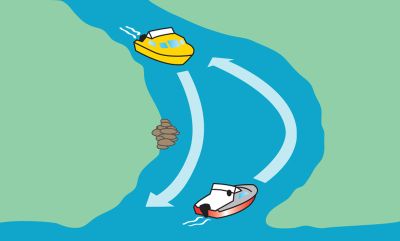Giving way, overtaking and avoiding collisions on the water
Rules and advice to help you understand how and when to give way, overtake safely and avoid collisions on the waterway – for all vessels.
Giving way
When vessels are approaching each other or overtaking, one has to give way to the other to avoid a collision. This includes vessels that are drifting or holding position without being anchored.
Which vessel gives way depends on the type of vessel and the situation.
The skippers of both vessels have a responsibility to take action to avoid a collision.
The vessel giving way must alter course or slow down to let the other vessel pass, and it must make its actions clear early. The vessel that has right of way must maintain course and speed, if it's safe to do so, and be prepared to take action to avoid a collision if necessary.
Powered vessels
Powered vessels – including personal watercraft (PWC) – must give way in the following situations.
When meeting head on, powered vessels must turn to starboard (right) and pass at a safe distance.

When crossing, powered boats must give way to the right.

A powered vessel must give way to a sailing vessel, unless it's being overtaken by the sailing vessel.

Sailing vessels
Sailing vessels – including sailboards and kiteboards – must give way in the following situations. (A sailing vessel using its engine must follow the same give way rules as powered vessels.)
A sailing vessel on a port tack must give way to a sailing vessel on a starboard tack.
A port tack is when the wind is blowing from the port (left) side of the vessel. A starboard tack is when the wind is blowing from the starboard (right) side of the vessel.
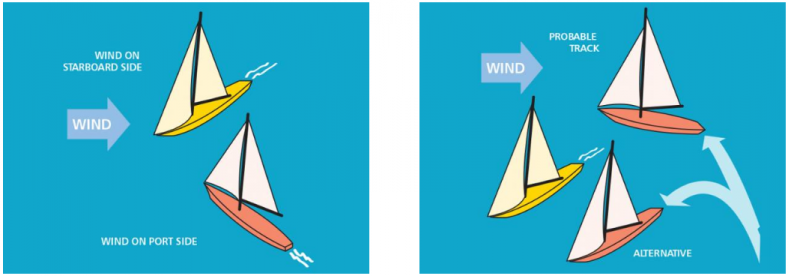
When both sailing vessels are on the same tack, the sailing vessel to windward – closest to where the wind is blowing from – must give way.
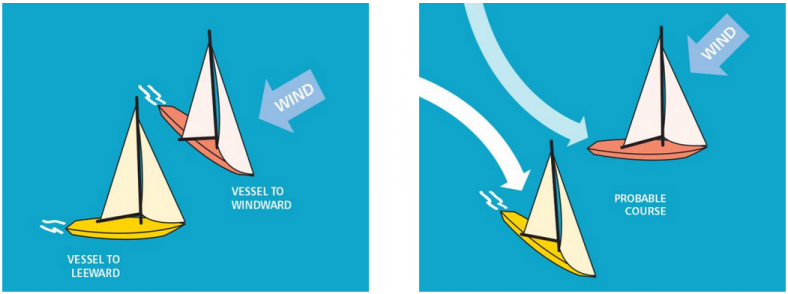
Sailing vessels must keep well clear of ferries on Sydney Harbour that display an orange diamond – see Sydney Harbour.
Paddlecraft and rowing vessels
It’s recommended that powered vessels and sailing vessels keep a proper lookout and give way to paddlecraft and rowing vessels.
Paddlecraft and rowing vessels should be aware that they sit low on the water and can be difficult for other vessels to see. You should take extra care when paddling near powered vessels and sailing vessels, and crossing channels and busy waterways. Like all other vessels, you have a responsibility to take action to avoid collision.
All vessels
All vessels – powered, sailing, paddlecraft and rowing – must also give way to the following vessels.
Vessel being overtaken
When overtaking, all vessels must give way to the vessel that's being overtaken.
Big ships
All vessels must keep well clear of big ships and other large vessels.
If you see a large vessel, keep a safe distance. Large vessels cannot always alter their course or stop quickly. Their stern swings out wide when turning and they lose steerage if they travel too slowly.
Keep well clear of big ships – they cannot always alter their course or stop quickly.
Large vessels travel much faster than they appear to. It may also be difficult for the master to see you, even when hundreds of metres away.
You must not cross:
- a channel if you're going to get in the way of a large vessel
- in front of a large vessel, unless well clear
- too close behind a large vessel.
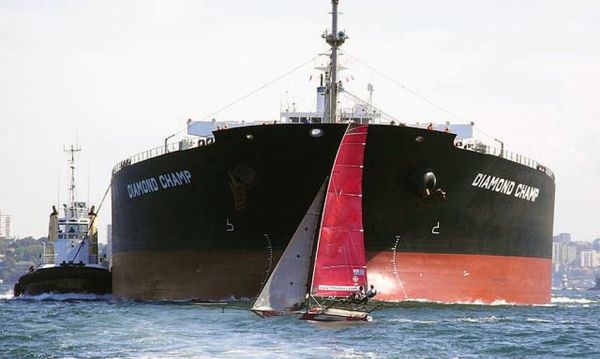
Dredges and work barges
All vessels must keep well clear of dredges and work barges, and take care when passing.
Dredges display shapes or lights to show that they have a limited ability to manoeuvre. The safe side to pass is shown by 2 diamonds. The other side is shown by 2 balls.
Work barges display a red flag and a yellow flag to signal to passing vessels to reduce their wash.
You must not create wash that may damage or unreasonably impact a dredge or work barge.
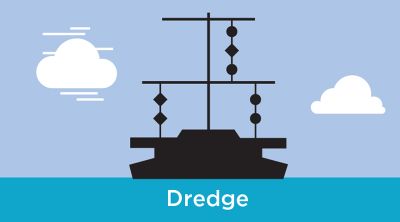
Vehicular ferries
In some areas, vehicular ferries pull themselves across channels using chains, ropes or cables. These ferries are significantly restricted in their ability to manoeuvre.
If a vehicular ferry is moving, all vessels must:
- slow down to 4 knots or less within 100m of the chains, ropes or cables
- pass at a safe distance behind the ferry, preferably when it has reached the shore, to avoid getting tangled
- turn their power off when crossing the chains, ropes or cables.
For give way rules for passenger ferries, see Sydney Harbour.
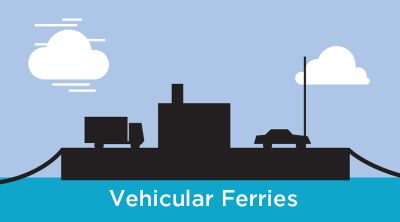
Commercial fishing vessels
All vessels must keep well clear of commercial fishing vessels. They use fishing equipment that restricts their ability to manoeuvre. These vessels display special shapes and lights – see Identifying vessels at night.
Overtaking
All vessels must keep well clear of a vessel they're overtaking.
You can overtake on either side of a vessel, but only when it's safe. You must overtake at a safe distance and at a safe speed. You must not cut in front of the vessel you're overtaking.
The vessel being overtaken must maintain course and speed, if it's safe to do so.


Avoiding collisions
As the skipper, you must take appropriate action to avoid a collision with another vessel.
You must take action – even when the skipper of the other vessel does not. If a collision takes place, both skippers can be held responsible.
If you're in any doubt about a situation, take action early. This could be:
- altering your course
- changing your speed – including stopping or reversing
- passing the other vessel
- letting the other vessel pass
- making a sound signal.
Make your actions big enough to be easily and clearly seen. Avoid making lots of small alterations to your course or speed.
Channels and rivers
It's recommended that all vessels keep to the starboard side in channels and rivers. This helps to make your actions clearer to vessels coming the other way and avoid the risk of collision.
If the channel or river is narrow, you must keep as far to starboard (right) side as is practical.
A channel is considered narrow when a vessel needs a large part of the channel to navigate. For example, when a vessel is restricted in its ability to manoeuvre or needs the deepest part of the channel to pass.
Always travel at a safe speed to avoid sudden dangers. Take extra care at bends, and never block a channel or river.
